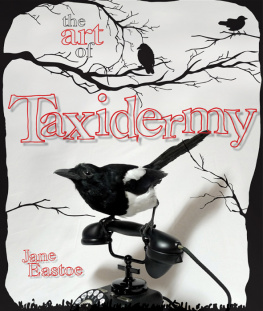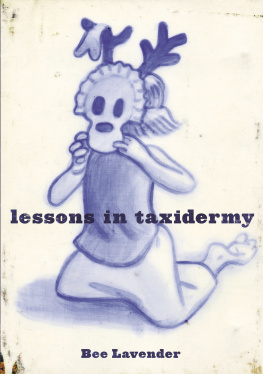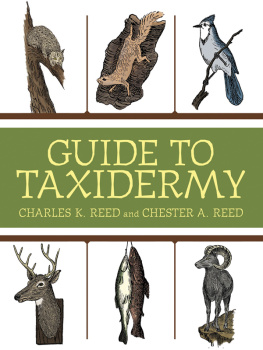TAXIDERMY ART

A Rogues Guide to the work, the culture, And how to do it yourself
Robert Marbury

CONT E NTS
Intr o duction

In 2004, artists Sarina Brewer, Scott Bibus, and I established the Minnesota Association of Rogue Taxidermists (MART). What began as a consortium of three local artists interested in natural history and the showmanship of oddities quickly grew into the first international organization devoted to the medium of Rogue Taxidermy (a term first coined by MART).
Since that time the community of Rogue Taxidermists and taxidermy artists has expanded considerably. Do-it-yourself workshops have popped up in cities from Los Angeles to London, as well as in oddities shops in between. Not since the Victorian era has taxidermy been so popular.
This book has been created to address this growing interest and to serve as a source of information and inspiration, from highlighting key figures in the development of taxidermy and showcasing the most exciting artists working in this medium today to providing workshops that can serve as jumping-off points for developing your own practice.
It is an exciting time for Rogue Taxidermy, with more resources and channels available to explore than ever before. Social media have allowed taxidermy work, art, and ideas to be shared in real time, all around the world. And if you have an interest in creating art with taxidermy or taxidermy-related materials, there is no better, or easier, time to start than now.
So without further delay, lets jump in.

A Taxidermy Pri m er
What Is Taxidermy?
From the ancient Greek taxi (to arrange) and dermis (skin), taxidermy is the preservation of an animals skin, fur, or feathers, and sometimes teeth, horns, and beak. A mount might contain bonesto help re-create the animals form, proper size, and articulationbut more than likely the interior will be filled with foam, resin, wood, plaster, or clay. (The muscle tissue and internal organs are removed, since they rot and smell quickly.) Taxidermy mounts are most commonly used as interior decoration, as a trophy from a hunt, or as a natural history specimen.
A Brief History
The first examples of animal preservation were the ancient Egyptians mummified pets, including cats, birds, and even gazelles. It wasnt until the fourteenth and fifteenth centuries that a crude form of taxidermy was developed when mounted and stuffed birds were used as decoys by falconers to lure birds of prey into their traps. For the next few centuries, most animal taxidermy, whether for scientific or trophy purposes, could be viewed as little more than upholstery work, with the skin simply stretched over wood or stuffed with rags and cotton. No real attempts were made at pest control or tanning. In the sixteenth century, a growing interest in the natural world led European princes and scholars to display animal specimens in their cabinets of curiosities (precursors to modern museums). As the taxidermy pieces became objects of interest, techniques were developed to repair, maintain, and better preserve the skins.
It wasnt until the end of the eighteenth century, however, with the development of arsenic soap, that a truly effective preservation method was developed. Although arsenic went out of fashion in the mid-1960s because of the poisonous effects of prolonged contact, there is no doubt that its use allowed the profession of taxidermy to flourish. By the time the first professional taxidermist business, Rowland Ward Ltd. of Piccadilly, opened in London in 1898, there was enough demand for hunting mounts that almost every town had a tannery that practiced taxidermy with some degree of success.
The height of taxidermys popularity may have come during the Victorian era. The 1851 Great Exhibition at the Crystal Palace in London featured many taxidermy specimens, including English taxidermist John Hancocks Struggle in the Quarry, featuring a gyrfalcon attacking a heron grasping an eel. A major attraction at the exhibition, his mounts realistically portrayed the animals in action, something that taxidermists had not been able to achieve up to this point.
Around this same time, American taxidermists Martha Ann Maxwell, Carl Akeley, and William Hornaday began to showcase animals in their own worlds. It was thought that this would allow the viewer to be better able to relate to the creatures and therefore feel a desire to protect them and their natural habitats. Once hugely popular in natural history museums, habitat dioramas have been edged out, replaced by multimedia exhibits that draw in larger crowds and greater revenue.
Trophy mounts continue to be a profitable taxidermy venture. Hunters who wish to memorialize their expeditions are prepared to pay a premium for the best possible results, and the business behind trophy mounting continues to motivate technical developments and the increasing availability of taxidermy and taxidermy materials. The last decade has seen an increased interest in taxidermy far beyond the hunting lodge, however. Thanks to interior decorators and fashion designers, restaurant owners and art dealers, the visibility and demand for taxidermy have exploded.
Taxidermy and the Law
Taxidermy and conservation are perpetually linked, and the laws that govern both have been created to aid both the profession and the animals. Knowing and following these laws protects you, protects the animals that are restricted, and protects the taxidermy community in general. While it can be challenging to get answers to questions that fall in the gray areas of animal legislation, there are laws that every artist working with animal parts must knowignorance is never an acceptable excuse. (See , for a full list of websites that explain the laws governing animal stewardship.) Here are the six key pieces of legislation that affect taxidermy:
Convention on International Trade in Endangered Species of Wild Fauna and Flora (CITES)
CITES is a multinational treaty that protects endangered animals and plants. The largest multinational conservation agreement, it has three appendixes. CITES I covers 1,200 species of animals and plants that are threatened with extinction. CITES II covers 21,000 species of animals and plants that may become threatened with extinction due to trade. CITES III covers 170 species of animals that individual nations protect. CITES deals primarily with the international transportation of illegally killed or possessed animals. (If the trade can be stopped, then poaching will be devalued.) This legislation affects anyone who buys or sells mounts, skins, or animal parts internationally, but trading an animal on this list anywhere requires a CITES tag to prove where it came from and how it got to you.
Migratory Bird Treaty Act of 1918 (MBTA)
This act applies to 800 species of migratory birds and protects birds both living and dead, as well as their eggs, nests, and feathers. MBTA replaced the Weeks-McLean Act, which was enacted in 1913 to combat the growing popularity of using migratory bird feathers in womens hats. The United States, Canada, Great Britain, Mexico, Japan, and Russia have all incorporated treaties under MBTA.












 A Taxidermy Pri m er
A Taxidermy Pri m er